 W
WActinoceramus is an extinct genus of fossil saltwater clams, marine pteriomorphian bivalve molluscs. These bivalves were facultatively mobile infaunal suspension feeders.
 W
WAgerostrea is an extinct genus of fossil oysters, marine bivalve molluscs in the family Ostreidae, the true oysters. The genus Agerostrea is present in the Maastrichtian, the upper stage of the Late Cretaceous epoch, from 72.1 to 66 million years ago.
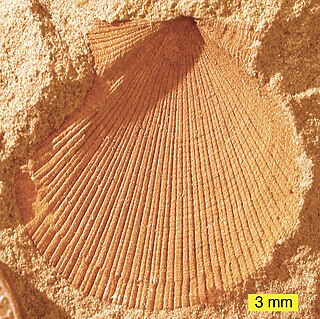 W
WAviculopecten is an extinct genus of bivalve mollusc that lived from the Early Devonian to the Late Triassic in Asia, Australia, Europe, North America, and South America.
 W
WBaluchicardia is an extinct genus of fossil saltwater clams, marine bivalve molluscs in the family Carditidae. These clams were facultatively mobile infaunal suspension feeders.
 W
WCaprina is a genus of rudists, a group of marine heterodont bivalves belonging to the family Caprinidae.
 W
WCaprinidae is a family of rudists, a group of unusual extinct saltwater clams, marine heterodont bivalves in the order Hippuritida.
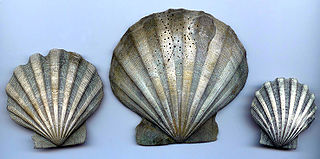 W
WChesapecten jeffersonius is the fossilized form of an extinct scallop, which lived in the early Pliocene epoch between four and five million years ago on Virginia's coastal plain. Chesapecten jeffersonius are commonly found in strata exposed along Coastal Plain cliffs along major rivers in southeastern Virginia and eastern North Carolina, and it is the index fossil for the Lower Yorktown Formation.
 W
WClaraia is an extinct genus of scallop-like bivalve molluscs that lived from the Capitanian stage of the Late Permian to the Anisian stage of the Middle Triassic, 266-237 million years ago. Fossils have been found worldwide in North America, Europe, Asia, Africa, and Australia. These are common fossils subsequent to the Permian-Triassic boundary, suggesting that the genus experienced rapid diversification during and after the Permian–Triassic extinction event, around 251.4 million years ago.
 W
WCucullaea gigantea is an extinct species of false ark shell found in the United States, in the Aquia Formation in Maryland and Virginia along the Potomac River and its tributaries, and in Alabama. They flourished in marine environments during the Paleocene, ranging from 58.7–55.8 million years ago.
 W
WCyrenida is an extinct genus of clams in the family Cyrenidae. This name is now accepted as a synonym of Corbicula Megerle von Mühlfeld, 1811.
 W
WDaonella is a genus of oyster-like saltwater clams, marine bivalve mollusks which lived in the middle to late Triassic period. They are related to the genera Aparimella and Halobia. Since they were ubiquitous in the Arctic, Tethys and Panthalassa seas, they are frequently used as index fossils in dating rocks to the Triassic period. However, the systematic classification of the Daonella is still an area of ongoing research.
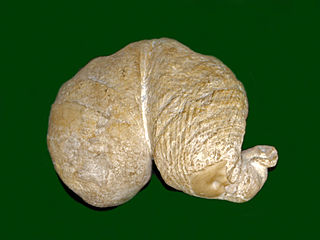 W
WDiceras is an extinct genus of fossil saltwater clams, marine heterodont bivalve molluscs. These bivalves were stationary epifaunal suspension feeders.
 W
WDiceratidae is a family of rudists, a group of unusual extinct saltwater clams, marine heterodont bivalves in the order Hippuritida.
 W
WDicerocardiidae is an extinct family of fossil saltwater clams, marine heterodont bivalve molluscs, in the order Megalodontida.
 W
WDicerocardium is an extinct genus of fossil saltwater clams, marine heterodont bivalve molluscs, in the family Dicerocardiidae. These bivalves were stationary semi-infaunal suspension feeders.
 W
WExogyra is an extinct genus of fossil marine oysters in the family Gryphaeidae, the foam oysters or honeycomb oysters. These bivalves grew cemented by the more cupped left valve. The right valve is flatter, and the beak is curved to one side. Exogyra lived on solid substrates in warm seas during the Jurassic and Cretaceous periods.
 W
WGryphaea, common name devil's toenails, is a genus of extinct oysters, marine bivalve mollusks in the family Gryphaeidae.
 W
WGryphaea arcuata is an extinct species of foam oyster, a bivalve mollusc in the family Gryphaeidae from the Early Jurassic of Europe.
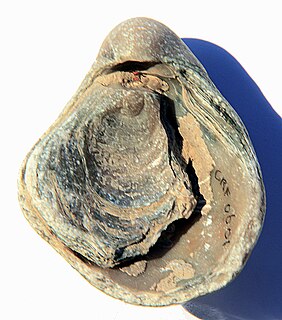 W
WGryphea dilatata, common name "devil's toenail" is a species of Jurassic oyster, an extinct marine bivalve mollusc in the family Gryphaeidae.
 W
WHippurites is an extinct genus of bivalve mollusc in the rudist family, from the Late Cretaceous of Africa, Asia, Europe, North America, and South America.
 W
WHippurites atheniensis is an extinct species of fossil saltwater clam, a marine bivalve mollusk in the family Hippuritidae. These fossils occur in the Late Cretaceous deposits of Greece, Serbia, Dalmatia, Istria, Bosnia and Herzegovina, Slovenia, Bulgaria and Italy.
 W
WHippurites cornuvaccinum is a fossil saltwater clam, an extinct marine bivalve mollusk in the family Hippuritidae. These fossils occur in the Late Cretaceous deposits of southern Europe.
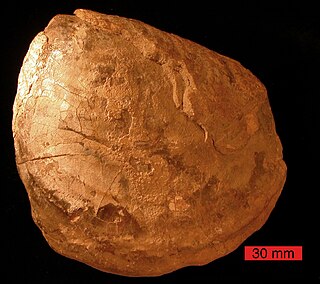 W
WThe Inoceramidae are an extinct family of bivalves ("clams") in the Class Mollusca. Fossils of inoceramids are found in marine sediments of Permian to latest Cretaceous in age. Inoceramids tended to live in upper bathyal and neritic environments.
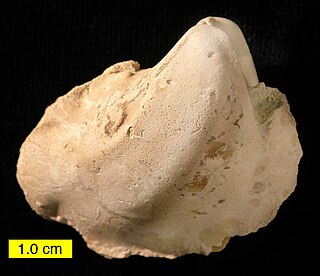 W
WLaevitrigonia is a genus of fossil clams, marine bivalve mollusks in the family Trigoniidae. This bivalve is sometimes preserved with mineralized soft-tissue.
 W
WLunulicardia is a genus of saltwater clams, marine bivalve molluscs in the family Cardiidae, the cockles. Fossils species in this genus are present in the Pliocene deposits of Indonesia and the Miocene deposits of Russia.
 W
WMegalodon is an extinct genus of bivalve molluscs that reportedly lived from the Devonian to the Jurassic period. It is not clear, however, that all the fossils assigned to Megalodon from that span of time really belong in the same genus. Jurassic relatives of Megalodon such as Pachyrisma grande were closely related to the rudists.
 W
WMegalodontidae is an extinct family of bivalve molluscs that reportedly lived from the Devonian to the Jurassic period.
 W
WMegatrigoniidae is an extinct family of fossil saltwater clams, marine bivalve molluscs in the subclass Palaeoheterodonta. This family of bivalves is known in the fossil record from the Jurassic period, Tithonian age, to the Cretaceous period, Maastrichtian age. Species in this family were facultatively mobile infaunal suspension feeders.
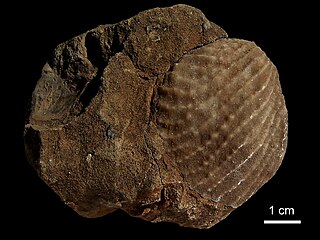 W
WMyophorella is a genus of fossil saltwater clams, marine bivalve mollusks in the family Trigoniidae. These bivalves are sometimes preserved with mineralized soft tissue.
 W
WMyophoria is an extinct genus of bivalve mollusk from Europe belonging to the family Myophoriidae. Fossils are mainly found in Triassic rocks.
 W
WNeithea is an extinct genus of bivalve mollusks that lived from the Early Jurassic to the early Paleocene, with a worldwide distribution. Neithia sp. are inequivalve. That means that the two valves are not the same shape, the right valve being strongly concave and the left valve being flattened or concave. Sculpture consist of alternating strong and weaker radiating ribs.
 W
WNeomegalodon is an extinct genus of bivalve molluscs belonging to the family Megalodontidae.
 W
WPanenka is a genus of fossil saltwater clams, marine bivalve molluscs in the family Antipleuridae. Like most bivalves, these molluscs were suspension feeders. They lived in the Devonian Period.
 W
WPlagiostoma is a genus of fossil saltwater clams, marine bivalve mollusks in the family Limidae, the file clams.
 W
WPlatyceramus was a genus of Cretaceous bivalve molluscs belonging to the extinct inoceramid lineage. It is sometimes classified as a subgenus of Inoceramus.
 W
WPterorigonia is an extinct genus of saltwater clams, marine bivalve molluscs in the family Megatrigoniidae. This genus is known in the fossil record from the Jurassic period Tithonian age to the Cretaceous period Maastrichtian age. Species in this genus were facultatively mobile infaunal suspension feeders. The type species of the genus is Pterotrigonia cristata.
 W
WPycnodonte is a genus of extinct oysters, fossil marine bivalve mollusks in the family Gryphaeidae, the foam oysters or honeycomb oysters. Shells of species in this genus are found around the world in fossil shell beds from the Valanginian to the Early Pleistocene. They are a commonly found fossil in Cretaceous shellbeds of the Navesink Formation in New Jersey.
 W
WRamonalinidae is an extinct family of marine bivalve molluscs from the late Anisian. It was an edgewise-recliner with a flattened anteroventral surface and partially fused valves. They formed distinctive mud mounds.
 W
WRequienia is an extinct genus of fossil saltwater clam, a marine bivalve molluscs in the order Hippuritida, family Requieniidae. These rudists lived in the Cretaceous period, from the Valanginian age (136.4–140.2) to the Campanian age. They were stationary intermediate-level suspension feeders.
 W
WTrigoniida is an order of medium-sized saltwater clams, marine bivalve molluscs. Within the fossil record the occurrence of this order is widespread, ranging from the Devonian Period to Recent.
 W
WTrigonioidea is superfamily of medium-sized saltwater clams, marine bivalve molluscs. Within the fossil record the occurrence of this superfamily is widespread, ranging from the Devonian Period to Recent.
 W
WVolviceramus is an extinct genus of fossil inoceramid bivalve mollusks from the Late Cretaceous of Europe and North America.